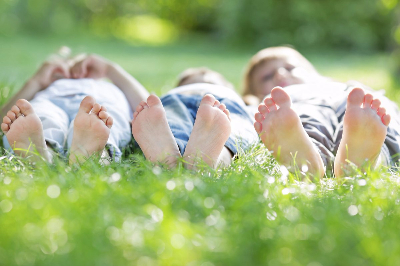Children Foot Health

Many adult foot ailments have their origin in childhood!Have your child’s feet examined and treated by foot specialists!
You worry about your children’s teeth, eyes, and other parts of the body. You teach washing, brushing, and grooming. But what do you do about your child’s developing feet which have to carry the entire weight of the body through a lifetime?
Many adult foot ailments have their origins in childhood and some are present at birth. Periodic professional assessment of their feet and lower legs can minimize these problems in later life.
Neglecting foot health invites problems in other parts of the body, such as the ankle, knees, hips and back.
It is advisable to seek help from a chiropodist if you notice one or more of the following:
- If your child often complains of foot or leg pain
- If your child walks awkwardly (pigeon-toed) or trips frequently
- If you notice excessive shoe wear
- If an arch doesn’t form when on tiptoe
- If your child’s toes turn under or overlap
- Warts
- Ingrown Toe Nails
- Athletes Foot
- If your child has flat feet
- In-toeing / Out-toeing
- If your child walks on tippy toes: toe walking
- Soreness & Cramps in feet and legs
Growth should not be a painful process. Soreness & cramping in feet and legs are not ‘normal’. Often parents are told that their children may ‘grow out of it’. This may be true in some cases but a level of reassurance from a foot specialist can go a long way in easing parents’ concern. Childhood conditions like flat feet, in-toeing / out-toeing, toe walking, curved feet and legs, knocked knee or bow legs can cause the child to walk and run in ways that are unnatural and damaging.
The feet of young children are often unstable because of muscle problems which make walking difficult or uncomfortable. A thorough examination by a chiropodist may detect an underlying defect or condition which may require immediate treatment or consultation with another specialist.
Chiropodists have long known of the high incidence of foot defects among the young, and recommends foot health examinations for school children on a regular basis.
At birth, feet are highly flexible, mouldable, collection of skin, soft tissue structures and partially developed bones. During the first year a large amount of natural unwinding must take place. Therefore, tight fitting clothing (i.e. sleeper pyjamas), socks, bed sheets or covers should never constrict a child’s foot. A flat foot appearance is normal in children up to the age of 4, due to the large amount of "baby” fat in the arch.Usually children should only start wearing shoes after they start walking independently, this allows the child’s foot muscles to work and strengthen naturally when learning to stand and walk.
A good child’s shoe should provide comfort, stability and protection. A shoe should have fastening; laces, buckles or Velcro for support. The heel of the shoe should fit snugly and be firm, so the heel does not slip up and down when walking. The toe box should be roomy enough to allow toes to wiggle freely. The sole should be lightweight and provide cushion as well as support. The shape of the shoe should match the shape of the child’s foot. Make sure the shoe is wide and long enough so the longest toe does not touch the end of the shoe when standing.
CHILDREN AND THEIR FEET. . .
It takes approximately 16 years for a child’s foot to fully develop.
While most parents recognize the need for proper fitting shoes during a child’s early walking years, few realize that the feet remain vulnerable to ill fitting footwear until the age of 16.
By their early teens, many children suffer foot problems associated with improper shoes. Many of these problems could be avoided.
Sports Activities
Millions of children participate in team and individual sports, many of them outside the school system, where advice on conditioning and equipment is not always available. Parents should be concerned about children’s involvement in sports that require a substantial amount of running and turning, or involve contact. Protective taping of the ankles is often necessary to prevent sprains or fractures. Parents should consider discussing these matters with a chiropodist if they have children participating in active sports. Sports-related foot and ankle injuries are on the rise as more children actively participate in sports.
